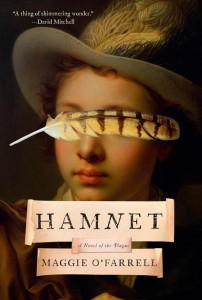
The year is 1596. Hamnet carefully, quietly descends the stairs, searching for an adult, anyone other than his abusive and often drunk grandfather. The child needs help because his twin sister Judith has fallen suddenly and disastrously ill. He doesn’t realise that his mother is off tending her swarming bees.
O’Farrell’s tour de force focuses on Agnes, Hamnet’s mother, Shakespeare’s wife, and in so doing immerses us in the day-to-day experience of raising children and managing a household in Elizabethan England. Agnes herself is an outlier in her society: the first thing we learn about her is that she keeps a falcon, unheard-of for a peasant much less a woman. Independent, strong-minded, more at home in the woods than anywhere else, she is an herbalist and a healer. She also has a mysterious ability, presumably from her long-dead mother, to read people’s fates.
What makes this novel so stunning is the author’s evocation of the details of each scene. Instead of tearing through a scene to keep the reader hopping, the author takes the time to richly imagine the sights and sounds, the minutest actions, staying with the scene until we are there, and stays there before moving on.
Suspense comes from our foreknowledge about Hamnet’s fate—perversely denied to his mother—and from the dual timelines: one being the year of Hamnet’s death, and the other the 1580s when Agnes and William begin a life together. A lengthy middle section describing how the plague made its way from a glass-blower in Italy to Judith in Stratford-upon-Avon may at first seem unnecessary, but it serves to increase the suspense as we long to return to that house on Henley Street.
That middle section also adds to our immersion in the period, envisioning how and why goods are packaged and transported, and what the costs are. I couldn’t help but be struck by the many people felled by the plague during its journey, people whom we don’t have time to mourn as we mourn for Judith and Hamnet.
What we know about Shakespeare comes mostly from his work. What we know about his son Hamnet is simply that he died at the age of 11, four years before Hamlet was written. What we know about Shakespeare’s wife is only a name, which is probably wrong.
The way the author uses names, starting with the title, gives us the frame for this book. The epigraph, a quote from Stephen Greenblatt, tells us that Hamnet and Hamlet were used interchangeably at the time. Similarly, his mother, who was called Agnes in her father’s will, is the woman we know as Anne Hathaway. Shakespeare himself is never named in this novel, instead called the glover’s son, the Latin tutor, her husband. My book club debated why, deciding that the book was not meant to be about him. One person astutely suggested that the author didn’t want us to think about Shakespeare the bard, but Shakespeare the man.
Our name is tied to our identity, so by introducing this uncertainty, the author reminds us how little we can know of each other, whether that other is in the past or our present. Members of my book club could not help but be struck by how many of the playwright’s works deal with misunderstandings and misinterpretations, switched and mistaken identities.
Every reference I’ve seen to Anne Hathaway depicts her as an older woman preying upon young Will, forcing marriage on him by getting pregnant. In truth, though, we know almost nothing about this woman—basically just the mentions of her in her father’s will and her husband’s—as we know nothing about the many women who loved, married, and bore children in obscurity.
Thus, though I am usually wary of fictional representations of real people who are not alive to defend themselves—per Milan Kundera’s masterful Immortality—here I welcome this reimagining of a woman and her passionate relationship with her husband.
In his review of Carole Angiers’ Speak, Silence: In Search of W.G. Sebald in the London Review of Books, Michael Wood writes:
Sebald’s deep preoccupation is with what his character Jacques Austerlitz calls ‘the marks of pain’, psychological and physical, in human and other animals. These marks are indelible, and for some people unforgettable.
Similarly, O’Farrell writes:
Every life has its kernel, its hub, its epicenter, from which everything flows out, to which everything returns. This moment is the absent mother’s: the boy, the empty house, the deserted yard, the unheard cry . . . It will lie at her very core, for the rest of her life.
Speaking from experience, I can say that the wrenching pages after Hamnet’s death truly capture a mother’s grief: the stunned emptiness, the guilt (contrary to all logic), the obsessive replaying of the child’s suffering, the eventual return to being able to function though changed, profoundly changed, forever.
As I am changed by this story. I was afraid to read it, despite the glowing reviews and recommendations, because I feared the pain. I’m grateful to my book club for giving me the impetus to gather my courage and begin. As Agnes discovered, art can help heal our heart’s wounds. So I say to you, go ahead. Give yourself over to this extraordinary book.
What book have you put off reading?
